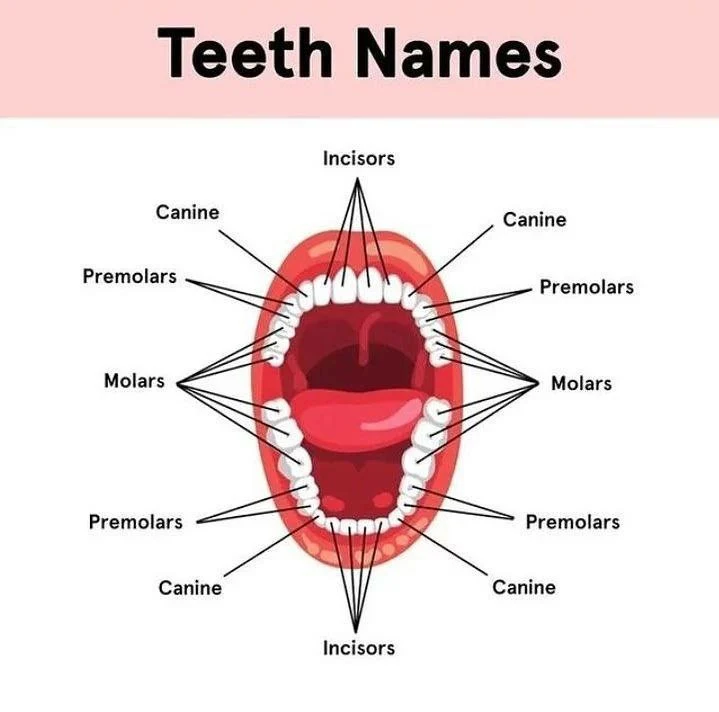Our teeth do far more than help us chew — they play a critical role in our speech, facial structure, digestion, and overall health. But not all teeth are the same. Each type has a specific function and position in the mouth. Understanding the names, structure, and roles of these teeth is essential for anyone studying dentistry, biology, or simply looking to maintain better oral hygiene.
In this detailed guide, we’ll explore the four main types of human teeth: incisors, canines, premolars, and molars — their locations, roles in the digestive process, and how to keep each type healthy.
What Are the Names of the Human Teeth?
The human adult mouth typically contains 32 permanent teeth, divided into different categories based on their shape and function. The four main types are:
- Incisors – 8 in total (4 upper, 4 lower)
- Canines – 4 in total (2 upper, 2 lower)
- Premolars (Bicuspids) – 8 in total (4 upper, 4 lower)
- Molars – 12 in total, including 4 wisdom teeth (6 upper, 6 lower)
1. Incisors: The Cutting Edge
Location: Front and center of the upper and lower jaws
Number: 8 (4 upper, 4 lower)
Function: Cutting and slicing food
Incisors are the first teeth to erupt in children and are most visible when we smile or speak. Their sharp, chisel-shaped structure is perfect for cutting through food.
Example: Biting into an apple? That’s your incisors at work.
2. Canines: The Tearing Tools
Location: Beside the incisors
Number: 4 (2 upper, 2 lower)
Function: Tearing and gripping food
Canine teeth are pointed and slightly longer than incisors. Also known as cuspids, they play a vital role in grasping and tearing tough foods like meat.
Fun Fact: Canines are also known as “eye teeth” because of their position under the eyes.
3. Premolars: The Bridge Between Tearing and Grinding
Location: Between the canines and molars
Number: 8 (4 upper, 4 lower)
Function: Crushing and tearing food
Premolars have a dual-cusped surface, making them effective for both tearing and grinding. They begin to erupt around age 10–12, replacing the primary molars in children.
Importance: They act as transitional teeth, blending the functions of sharp canines and flat molars.
4. Molars: The Master Grinders
Location: At the back of the mouth
Number: 12 (6 upper, 6 lower — includes wisdom teeth)
Function: Grinding and chewing food
Molars have a broad, flat surface ideal for breaking down food into digestible particles. The first molars appear around age 6, second molars by age 12, and third molars (wisdom teeth) between 17–25, if at all.
Wisdom Teeth Note: Often removed due to overcrowding or impaction.
Teeth Development Timeline: When Do Teeth Erupt?
| Type of Tooth | Primary Eruption | Permanent Eruption |
|---|---|---|
| Incisors | 6–12 months | 6–8 years |
| Canines | 16–20 months | 9–12 years |
| Premolars | N/A (no baby premolars) | 10–12 years |
| Molars | 12–28 months | 6–13 years (+ wisdom at 17–25) |
Dental Formula: How Many Teeth Do Humans Have?
- Children (Deciduous Teeth): 20 teeth → 2 incisors, 1 canine, 2 molars per quadrant
- Adults (Permanent Teeth): 32 teeth → 2 incisors, 1 canine, 2 premolars, 3 molars per quadrant
Dental Formula for Adults:
= 32 total
Functions of Each Tooth Type in Digestion
| Tooth Type | Primary Role | Digestive Impact |
|---|---|---|
| Incisors | Cut and slice food | Makes food manageable |
| Canines | Tear and grip food | Breaks tough materials |
| Premolars | Crush and tear | Prepares food for swallowing |
| Molars | Grind and chew thoroughly | Aids enzyme action |
Common Dental Conditions by Tooth Type
- Incisors: Susceptible to chips, fractures, and aesthetic issues like discoloration
- Canines: May be impacted (fail to erupt), especially the upper canines
- Premolars: Prone to decay in pits and fissures
- Molars: Commonly affected by cavities and wisdom tooth impaction
How to Care for All Types of Teeth
- Brushing Twice Daily – Use fluoride toothpaste and a soft-bristled brush.
- Flossing – Essential for cleaning between molars and premolars.
- Diet – Limit sugar to prevent decay; include calcium-rich foods.
- Dental Visits – Every 6 months for professional cleaning and checkups.
- Sealants – Especially for molars in kids to prevent early decay.
People Also Ask
What are the 4 main types of teeth?
The four types are incisors, canines, premolars, and molars, each with a unique shape and function in digestion.
How many teeth do adults have?
Adults have 32 teeth, including 4 wisdom teeth. Children have 20 primary (baby) teeth.
What is the function of canine teeth?
Canines are pointed teeth used for tearing and gripping food, especially meat.
Which teeth are used for grinding food?
Molars are used to grind and crush food at the back of the mouth.
Are premolars present in baby teeth?
No, premolars are not part of baby teeth. They erupt later during the permanent dentition phase.



